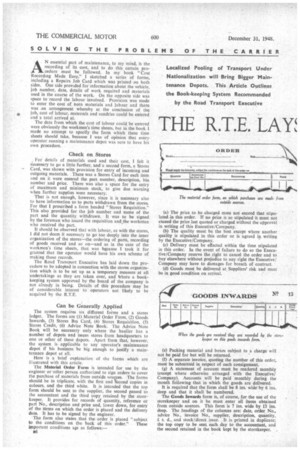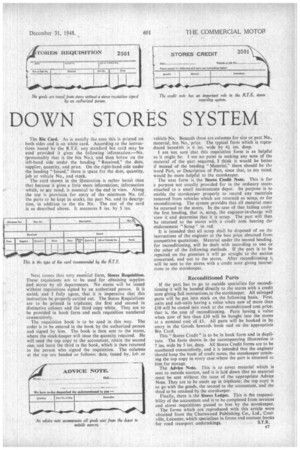THE R.T.E. LAY DOWN STORES SYSTEM
Page 40

Page 41

If you've noticed an error in this article please click here to report it so we can fix it.
Localized Pooling of Transport Under Nationalization will Bring Bigger -Maintenance Depots. This Article Outlines the Book-keeping System Recommended
by the Road Transport Executive
AN essential part of maintenance, to my mind, is the recording of its cost, and to do this certain procedure must be followed. In my book "Cost Recording Made Easy," I sketched a series of forms, including a Repairs Job Card which was printed on both sides. One side provided for information about the vehicle, job number, date, details of work required and materials used in the course of the work. On the opposite side was space torecord the labour involved. Provision was made to enter the cost of bola materials and labour and there was an arrangement whereby at the conclusion of the
• job, cost of labour, materials and sundries could be entered and a total arrived at.
The data from which the cost of labour could be entered were obviously the workmen's time sheets, but in the book I made no attempt to specify the form which these time sheets should take, because I was of opinion that every operator running a maintenance depot was sure to have his own procedure.
Check on Stores For details of materials used and their cast, I felt it zieeessary to go a little further, and 'a second form, a Stores Card, was shown wins provision for entry of incoming and outgoing materials. There was a Stores Card for each item and on it were entered the part number, description, bin number and price. There was also a space for the entry of maximum and minimum stock, to give due warning when further supplies were necessary.
That is not enough, however, since it is necessary also to have information as to parts withdrawn from the stores. For that I prescribed a form headed "Stores Requisition." This also provided for the job number and name of the part and the quantity withdrawn. It was to be signed by the foreman who issued the requisition and.the workman who received the part.
It should be observed that with labour, as with the stores, I did not deem it necessary to go too deeply into the inner organization of the stores—the ordering of parts, recording of goods received and so on—and as in the case of the workmen's time sheets, that was because I took it for granted that the operator would have his own scheme of making those records.
The Road Transport Executive has laid down the procedure to be adopted in connection with the stores organization which is to be set up as a temporary measure at all undertakings as they are taken over, and tvhere a bookkeeping system approved by the board of the company is not already in being. Details of this procedure may be of considerable interest to operators not likely to be acquired by the R.T.E.
Can be Generally Applied The system requires six different foins and a stores ledger. The forms are (1) Material Order Form, (2) Goods Inwards, (3) Stores Bin Card, (4) Stores Requisition, (5) Stores Credit, (6) Advice Note Book. The Advice Nate Book will be necessary only where the haulier has a number of depots and issues stores from headquarters to one or other of these depots. Apart from that, however, the system is applicable to any operator's maintenance depot if his business be big enough to justify a maintenance depot at all.
Here is a brief explanation of the forms which are il:ustrated with this article.
The Material Order Form is intended for use by the engineer or-other person authorized to sign orders to cover the purchase of materials from outside soueess. The forms should be in triplicate, with the first and Ucond copies in colours, and the third white. It is intended that the top form should be sent to the supplier, the second passed to the accountant and the third copy retained by the storekeeper. It provides for records of quantity, reference or part No., description and price and, lower down, for entry of the terms on which the order is placed and the delivery date. It has to be signed by the engineer.
The form also states that the order is placed "subject to the conditions on the back of this order." These important conditions age as follows:— 96 (a) The price to be charged must not exceed that stipulated in this order. If no price is so stipulated it most not exceed the price last quoted or charged without the approval in writing of this Executive/Company.
(b) The quality must be the best except where another quality is stipulated in this order or is agreed in. writing by the Executive/Company. (c) Delivery must be effected within the time stipulated in this order. In the event of failure to do so the Executive/Company reserve the right to cancel the order and to buy elsewhere without prejudice to any right the Executive! Company may have to damages for breach of contract.
(d) Goods must be delivered at Suppliers' risk and must be in good condition on arrival.
(e) Packing material and boxes subject to a charge will not be paid for but will be returned. (f) A separate invoice, quoting the number of this order, must be submitted in respect of each consignment.
(g) A statement of account must be rendered monthly (except where otherwise arranged with the Executive/ Company). Accounts will be paid monthly during the month following that in which the goods are delivered.
It is required that the form shall be 8 ins. wide by 6 ins. deep and that it shall be numbered. The Goods Inwards form is, of course, for the use of the storekeeper and on it he must enter all items obtained from outside sources. This form is 7 ins, wide by 13 ins. deep. The headings of the columns are: date, order No,, advice No., invoice No., supplier, description, quantity, s. d., and stock/direct issue. It is printed in duplicate; the top copy to be sent. each day to the accountant, and the second retained in the book kept by the storekeeper. ,
The Bin Card. As is usually the case this is printed on both sides and is on white card. According to the instructions issued by the R.T.E. any standard bin card may be used provided it gives the following information:—No. (presumably that is the bin No.), and then below on the left-hand side under the heading " Received," the date, supplier, quantity, and price. On the right-hand side under the heading "Issued," there is space for the date, quantity, job or vehicle No., and stock.
The card shown in the illustration is rather better than that because it gives a little more information; information which, to lily mind, is essential to the end in view. Along the top is provision for entry of the minimum No. (of the parts to be kept in stock), the part No. and its description, in addition to the bin No. The rest of the card is as described above. It measures 8 ins. by 5 ins.
Next comes that very essential form, Stores Requisition. These requistions are to be used for obtaining supplies and stores by all departments. No stores will be issued without requisitions signed by an authorized person. It iS stated, and I fully agree, that it is imperative that this instruction be property carried out. The Stores Requisitions are to be printed in triplicate; the first and second in distinctive colours and the third copy white. They are to be provided in book form and each requisition numbered consecutively.
The requisition book is to be used in this way. The order is to be entered in the book by the authorized person and signed by him. The book is then sent to the stores, where the stock-keeper will issue the quantity required. He will send the top copy to the accountant, retain the second one, and leave the third in the book, which is then returned to the person who signed the requisition. The columns at the top arc headed as follows: date, issued by. job or
vehicle No. Beneath these are columns for size or part No.. material, bin No., price. The typical form which is reproduced herewith is 6 ins, wide by 41 ins. deep.
I am not sure that this requisition form is as helpful as it might be. I see no point in making any note of the material of the part. required, I think it would be better if instead of the heading " Material," there should be the word Part, or Description of Part, since that, to my mind. would be more helpful to the storekeeper.
The next form is the Stores Credit Note. This is for a purpose not usually provided for in the ordinary stores attached to a small maintenance depot. Its purpose is to enable the storekeeper properly to record any materials removed from vehicles which are returmid as scrap, or for reconditioning. The system provides that all material must be returned to the stores. In the case of that falling under the first heading, that is, scrap, the engineer-in-charge will view it and determine that it is scrap. The part will then be returned to the stores with a credit note bearing the endorsement 'Scrap" in red.
It is intended that all scrap shall be disposed of on the instructions of the engineer at the best price obtained front competitive quotations. Material under the second heading. for reconditioning, will be dealt with according to one or the other of the following methods. If the part is to be repaired on the premises it will go straight to the section concerned, and not to the stores. After reconditioning it will be sent to the stores with a credit note giving instructions to the storekeeper.
Reconditioned Parts
If the part has to go to outside specialists for reconditioning it will be handed directly to the stores with a credit note giving full instructions,to the storekeeper. All salvaged parts will be put into stock on the following basis. First. units and sub-units having a value when new of more than £10 will be costed into stock at the reconditioned cost price: that is, the cost of reconditioning. Parts having a value when new of less than £10 will be bought into the stores at a nominal cost of LI. All parts will be booked in by entry in the Goods Inwards book and on the appropriate Bin Card.
This "Stores Credit" is to be in book form and in duplicate. The form shown in the accompanying illustration is 7 ins, wide by 5 ins. deep. All Stores Credit forms are to be numbered consecutively, and it is intended that the engineer should keep the book of credit notes, the storekeeper retaining the top copy in every ease wherethe part is returned to him for storage. The Advice Note. This is to cover material which is sent to outside sources, and it is laid down that no material must be sent without the issue of the appropriate Advice Note. They are to be made up in triplicate; the top copy is to go with the goods, the second to the accountant, and the third to be retained by the storekeeper.
Finally, there is the Stores Ledger. This is the responsibility of the accountant and is to be completed from invoices and stores requisitions passed to him by the storekeeper. The forms which are reproduced with this article were obtained from the Charnwood Publishing Co., Ltd., Coalville, Leicester, which specializes in forms and account books for road transport undertakings. S.T.R.




























































































